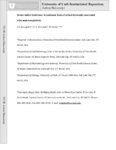Filters: Collection: "ir_uspace" Type: "Text"
1 - 25 of 13
| Creator | Title | Description | Subject | Date | ||
|---|---|---|---|---|---|---|
| 1 |
 |
Bernstein, Paul S.; Zabriskie, Norman A.; Zhang, Kang | CFH Y402H Confers similar risk of soft Drusen and both forms of advanced AMD | BACKGROUND: Age-related macular degeneration (AMD) is the most common cause of irreversible visual impairment in the developed world. The two forms of advanced AMD, geographic atrophy and neovascular AMD, represent different pathological processes in the macula that lead to loss of central vision. S... | 2005 | |
| 2 |
 |
Baehr, Wolfgang | Receptors for advanced glycation end products as progressive factors in age-related macular degeneration | Advanced glycation end products (AGE) exacerbate disease progression through two general mechanisms: modifying molecules and forming nondegradable aggregates, thus impairing normal cellular/tissue functions, and altering cellular function directly through receptor-mediated activation. In the prese... | Advanced glycation end products; AGE; receptor for AGE-mediated cellular activation; RAGE | 2004 |
| 3 |
 |
Digre, Kathleen B.; Mamalis, Nick; White, George L. Jr. | Congenital anomalies of the optic nerve in one family. | We present three cases of congenital optic disc anomalies in one family who underwent an extensive diagnostic workup to exclude any intracranial pathology. One patient had elevated optic nerve heads and was hospitalized for multiple diagnostic tests including a lumbar puncture and magnetic resonance... | Optic Nerve; Congenital Anomalies | 1992-04-24 |
| 4 |
 |
Frederick, Jeanne M.; Baehr, Wolfgang | Receptor for advanced glycation end products and age-related macular degeneration. | Advanced glycation end products (AGE) exacerbate disease progression through two general mechanisms: modifying molecules and forming nondegradable aggregates, thus impairing normal cellular/tissue functions, and altering cellular function directly through receptor-mediated activation. In the present... | Optic Atrophies, Hereditary; Apoptosis; Pigment Epithelium of Eye | 2004 |
| 5 |
 |
Bernstein, Paul S.; Leppert, Mark F. | Genotype-phenotype analysis of ABCR variants in macular degeneration probands and siblings | PURPOSE: Single-copy variants of the autosomal recessive Stargardt disease (STGD1) gene ABCR (ABCA4) have been shown to confer enhanced susceptibility to age-related macular degeneration (AMD). To investigate the role of ABCR alleles in AMD further, genotype-phenotype analysis was performed on sibli... | DNA Mutational Analysis; Nuclear Family; Phenotype | 2002 |
| 6 |
 |
Olson, Randall J.; Spencer, Terrence S.; Mamalis, Nick | Three-year clinical comparison of 3-piece AcrySof and SI-40 silicone intraocular lenses | PURPOSE: To compare the 3-year performance of the 3-piece AcrySof (Alcon) and the SI-40 silicone (Allergan) intraocular lenses (IOLs). SETTING: John A. Moran Eye Center, University of Utah, Salt Lake City, Utah, USA. METHODS: In this retrospective study, patients with no complications and at least a... | Acrylic Resins; Silicone Elastomers; Prosthesis Design; Postoperative Complications; Patient Satisfaction; Cataract | 2002-07 |
| 7 |
 |
Bernstein, Paul S. | Evaluation of the G protein coupled receptor-75 (GPR75) in age related macular degeneration | 2001 | ||
| 8 |
 |
Bernstein, Paul S. | Retinal tubulin binds macular carotenoids | PURPOSE: To investigate the biochemical mechanisms responsible for the specific uptake, concentration, and stabilization of the carotenoids lutein and zeaxanthin in the macula. METHODS: Soluble extracts of bovine retina mixed with radioactive carotenoids were purified by hydrophobic interaction, ion... | Chromatography, Gel; Electrophoresis; Xanthophylls | 1997 |
| 9 |
 |
Bernstein, Paul S.; Zabriskie, Norman A.; Zhang, Kang; Leppert, Mark F. | Diverse macular dystrophy phenotype caused by a novel complex mutation in the ELOVL4 gene | PURPOSE: A 5-bp deletion in ELOVL4, a photoreceptor-specific gene, has been associated with autosomal dominant (ad) macular dystrophy phenotypes in five related families, in which phenotypes range from Stargardt-like macular dystrophy (STGD3; Mendelian Inheritance in Man 600110) to pattern dystrophy... | Linkage (Genetics); Middle Older people; Phenotype | 2001 |
| 10 |
 |
Frederick, Jeanne M. | Inactivity of human β,β-carotene-9′, 10-′dioxygenase (BCO2) underlies retinal accumulation of the human macular carotenoid pigment | The macula of the primate retina uniquely concentrates high amounts of the xanthophyll carotenoids lutein, zeaxanthin, and meso-zeaxanthin, but the underlying biochemical mechanisms for this spatial- and species-specific localization have not been fully elucidated. For example, despite abundant reti... | 2014-01-01 | |
| 11 |
 |
Bernstein, Paul S. | Transformations of selected carotenoids in plasma, liver, and ocular tissues of humans and in nonprimate animal models | PURPOSE: To determine the stereochemistry of carotenoids in human ocular tissues in comparison with plasma and liver and to elucidate the possible transformations of dietary (3R,3'R,6'R)-lutein and (3R,3'R)-zeaxanthin in the eye. Similarly, to characterize the carotenoid profiles in the eye tissues,... | Chromatography, High Pressure Liquid; Stereoisomerism; Xanthophylls | 2002 |
| 12 |
 |
Bernstein, Paul S. | Senior-Løken syndrome: a syndromic form of retinal dystrophy associated with nephronophthisis | Senior-Løken syndrome (SLS) is an autosomal recessive disease characterized by development of a retinitis (RP)- or Leber congenital amaurosis (LCA)-like retinal dystrophy and a medullary cystic kidney disease, nephronophthisis. Mutations in several genes (called nephrocystins) have been shown to ca... | 2012-01-01 | |
| 13 |
 |
Bernstein, Paul S.; Gellermann, Werner | Nonmydriatic fluorescence-based quantitative imaging of human macular pigment distributions. | We have developed a CCD-camera-based nonmydriatic instrument that detects fluorescence from retinal lipofuscin chromophores ("autofluorescence") as a means to indirectly quantify and spatially image the distribution of macular pigment (MP). The lipofuscin fluorescence intensity is reduced at all ret... | Cytology; Sensitivity and Specificity | 2006-10 |
1 - 25 of 13
